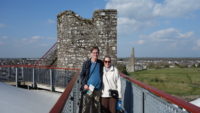 Sometimes coming up short on time is a huge help. Today, we got launched from Navan around 8:45, which was fine. We had 10:15 admission tickets to Bru na Boinne, the home of the Newgrange and Knowth chamber tombs (as well as many other smaller tombs). I had calculated we had time to go see another ruined abbey, one that has two of the finest high crosses in all of Ireland. What I hadn’t remembered was that I had made all of my time calculations from the village of Slane and not Navan, which is an added difference of twenty minutes. When we actually got to Slane, I decided we had to skip going to the former monastery, and I reset our GPS to Newgrange.
Sometimes coming up short on time is a huge help. Today, we got launched from Navan around 8:45, which was fine. We had 10:15 admission tickets to Bru na Boinne, the home of the Newgrange and Knowth chamber tombs (as well as many other smaller tombs). I had calculated we had time to go see another ruined abbey, one that has two of the finest high crosses in all of Ireland. What I hadn’t remembered was that I had made all of my time calculations from the village of Slane and not Navan, which is an added difference of twenty minutes. When we actually got to Slane, I decided we had to skip going to the former monastery, and I reset our GPS to Newgrange.
Computers are funny things. When you tell a GPS to get you to Newgrange, it will do that. What it won’t tell you is that you can’t get in to see the tomb without a ticket from the visitors’ center, which is across the Boyne River. Happily, we can read signs, and made the discovery after only a couple of miles (and before we got all the way to the monument). I corrected the GPS by asking it to take us to the visitors’ center.
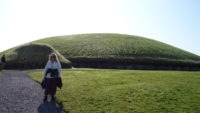 Computers are funny things. When you tell a GPS to take you to the visitors’ center, it will do that. What it won’t tell you is that the cow path of a road it wants to take you down will indeed be a slight shortcut to the center. We chose to follow the signs on the main road instead.
Computers are funny things. When you tell a GPS to take you to the visitors’ center, it will do that. What it won’t tell you is that the cow path of a road it wants to take you down will indeed be a slight shortcut to the center. We chose to follow the signs on the main road instead.
The Bru na Boinne (Newgrange) Center is a pretty great little museum. It has displays and videos explaining about the tombs and (a little) about the people who built them. You can go through the entire exhibit in about forty-five minutes, which is good, because that is all the time we had before our small bus left to take us to the sites. The quick lowdown on the tombs – there are three major passage tombs, but one is mostly unexcavated. The tombs are all about five thousand years old. The tour includes the two open ones, Knowth and Newgrange. We know little of how or why the people built the tombs, but some of the rock came from thirty miles away or more, and some of the stones weighed more than five tons. Knowth is a larger site, with the main tomb and several smaller tombs. You are allowed on the top of Knowth; since there has been a fort on top and a farm, I guess they figure it’s okay to let tourists on the boardwalks up top. Newgrange has the attraction of your actually being able to go inside the chamber.
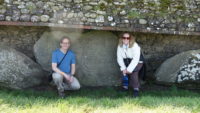 We left the center and walked across a very pretty pedestrian bridge across the Boyne River. A short walk led us to the parking lot, and there we met our bus. It took us out to Knowth first, where we spent about forty-five minutes exploring the grounds, which included going to the top. The tomb is surrounded by heavy skirt stones, some of which are decorated with geometric designs. From the top of the mound, you can see in all directions, and signs at the top told you what you were looking at. I found a distant-looking Hill of Tara and a very close Hill of Slane. I was much more excited about seeing the Hill of Slane from the mound that I had any right to be. I never actually recognize things from signs posted on hills or tall buildings, so I kept pointing it out to Meredith. She is a patient wife.
We left the center and walked across a very pretty pedestrian bridge across the Boyne River. A short walk led us to the parking lot, and there we met our bus. It took us out to Knowth first, where we spent about forty-five minutes exploring the grounds, which included going to the top. The tomb is surrounded by heavy skirt stones, some of which are decorated with geometric designs. From the top of the mound, you can see in all directions, and signs at the top told you what you were looking at. I found a distant-looking Hill of Tara and a very close Hill of Slane. I was much more excited about seeing the Hill of Slane from the mound that I had any right to be. I never actually recognize things from signs posted on hills or tall buildings, so I kept pointing it out to Meredith. She is a patient wife.
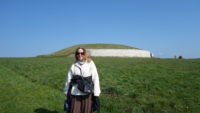 The bus then took us to Newgrange, where we spent another forty-five minutes on site. Meredith and I got to go in the tomb with the first group (of two), a tour of twelve people. You have to stoop in places to continue, and a couple of places are quite narrow, but we ended up in a small chamber shaped like a cross. The three small rooms used to hold human remains of important people. There were many designs etched into the stone in this section. Newgrange is famous for being built such that the interior of the tomb chamber is lit by the sun for a few minutes on the winter solstice. Our guide demonstrated it using a light bulb, and even that was impressive. You can go on the solstice to see it actually happen, if the weather is good and if you win a lottery of ten or so tickets out of thirty thousand entries.
The bus then took us to Newgrange, where we spent another forty-five minutes on site. Meredith and I got to go in the tomb with the first group (of two), a tour of twelve people. You have to stoop in places to continue, and a couple of places are quite narrow, but we ended up in a small chamber shaped like a cross. The three small rooms used to hold human remains of important people. There were many designs etched into the stone in this section. Newgrange is famous for being built such that the interior of the tomb chamber is lit by the sun for a few minutes on the winter solstice. Our guide demonstrated it using a light bulb, and even that was impressive. You can go on the solstice to see it actually happen, if the weather is good and if you win a lottery of ten or so tickets out of thirty thousand entries.
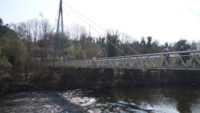 The outside of Newgrange is highly decorated with white and grey stones. The decoration is an interpretation from an archeologist who worked Newgrange in the 1970s. He found all the stones on the ground, decided they’d fallen from the outside of the tomb, and took an educated guess on how they might originally have been arranged. It created some controversy, but I like the effect myself. It looks more imposing and regal than just a mound of grass.
The outside of Newgrange is highly decorated with white and grey stones. The decoration is an interpretation from an archeologist who worked Newgrange in the 1970s. He found all the stones on the ground, decided they’d fallen from the outside of the tomb, and took an educated guess on how they might originally have been arranged. It created some controversy, but I like the effect myself. It looks more imposing and regal than just a mound of grass.
We headed back to the visitors’ center, where we ate a quick lunch (at 1:00). We were then off to the town of Trim. Trim got on my touring radar from having a fairly intact castle in it from around 1200, as well as having an interesting river walk. When my brother mentioned how much he liked Trim’s castle, it firmed up my determination to go see it.
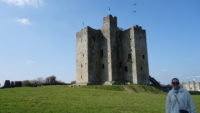 Trim’s castle was built by the Anglo-Normans as a power move, to firm up their rule of eastern Ireland. They started with a central keep/tower space, and eventually added outer walls and a moat. The grounds are free to tour, and a minimal fee gets you a forty-five minute tour of the interior, which included the roof. We did that, of course. The tour was interesting, and the views from the top were great on a sunny day like today. We both loved the tour.
Trim’s castle was built by the Anglo-Normans as a power move, to firm up their rule of eastern Ireland. They started with a central keep/tower space, and eventually added outer walls and a moat. The grounds are free to tour, and a minimal fee gets you a forty-five minute tour of the interior, which included the roof. We did that, of course. The tour was interesting, and the views from the top were great on a sunny day like today. We both loved the tour.
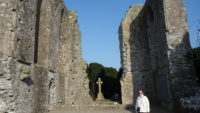 We then followed a walking tour from Mer’s favorite guidebook writer, Rick Steves. We followed the Boyne River for a ways, until we got to the ruins of a large Gothic church (all after having met two older gentlemen who talked to us about considering becoming Catholic – it is Ireland, after all). The ruins of the church were impressive, but so was the old (and still in use) cemetery surrounding it – it had huge trees growing all over, and many Celtic crosses for tombstones. It was a pretty spot, for ruins and a graveyard. We weren’t done being ruined yet, though – we continued on a little bit to a ruined church/hospital complex from the thirteenth century. We returned the way we came, and fit in one more quick ruin – the tower of an abbey destroyed by Cromwell; the tower used to be seven stories tall. It is still impressive even standing in ruins.
We then followed a walking tour from Mer’s favorite guidebook writer, Rick Steves. We followed the Boyne River for a ways, until we got to the ruins of a large Gothic church (all after having met two older gentlemen who talked to us about considering becoming Catholic – it is Ireland, after all). The ruins of the church were impressive, but so was the old (and still in use) cemetery surrounding it – it had huge trees growing all over, and many Celtic crosses for tombstones. It was a pretty spot, for ruins and a graveyard. We weren’t done being ruined yet, though – we continued on a little bit to a ruined church/hospital complex from the thirteenth century. We returned the way we came, and fit in one more quick ruin – the tower of an abbey destroyed by Cromwell; the tower used to be seven stories tall. It is still impressive even standing in ruins.
 So, if you are keeping ruins count, we’re up to six ruined abbeys and one castle, in two days. We would have seen even more in this area, but sometimes time is short.
So, if you are keeping ruins count, we’re up to six ruined abbeys and one castle, in two days. We would have seen even more in this area, but sometimes time is short.
I love that the Catholics are proselytizing you. Talk about about breaking stereotypes. Let me know they want someone to vouch for your worthiness to join the Catholic Church. 😉
I was pleased – evangelical Catholics. 🙂